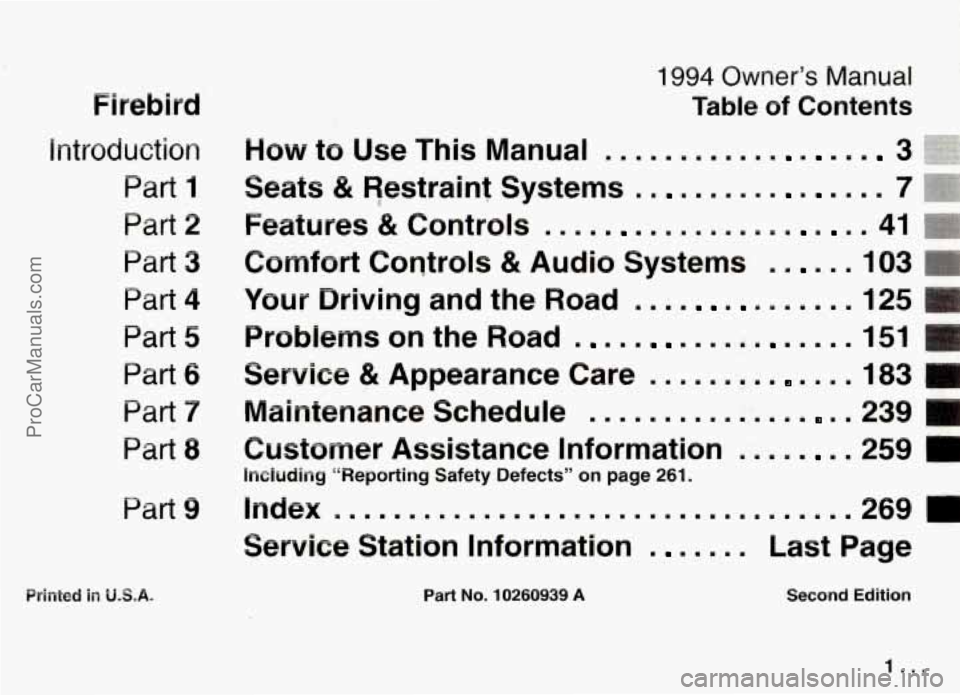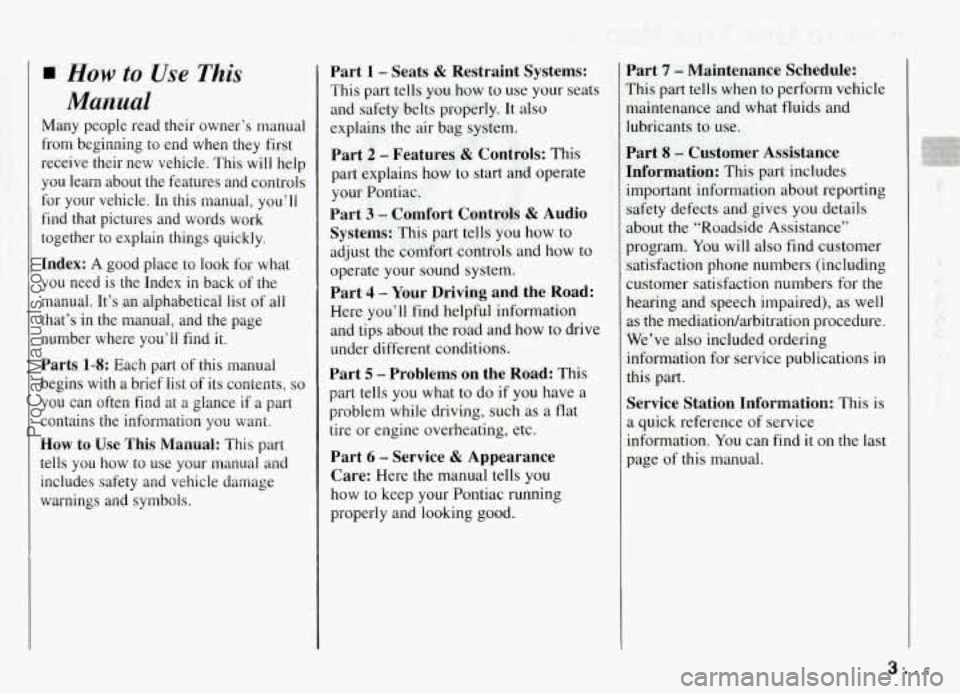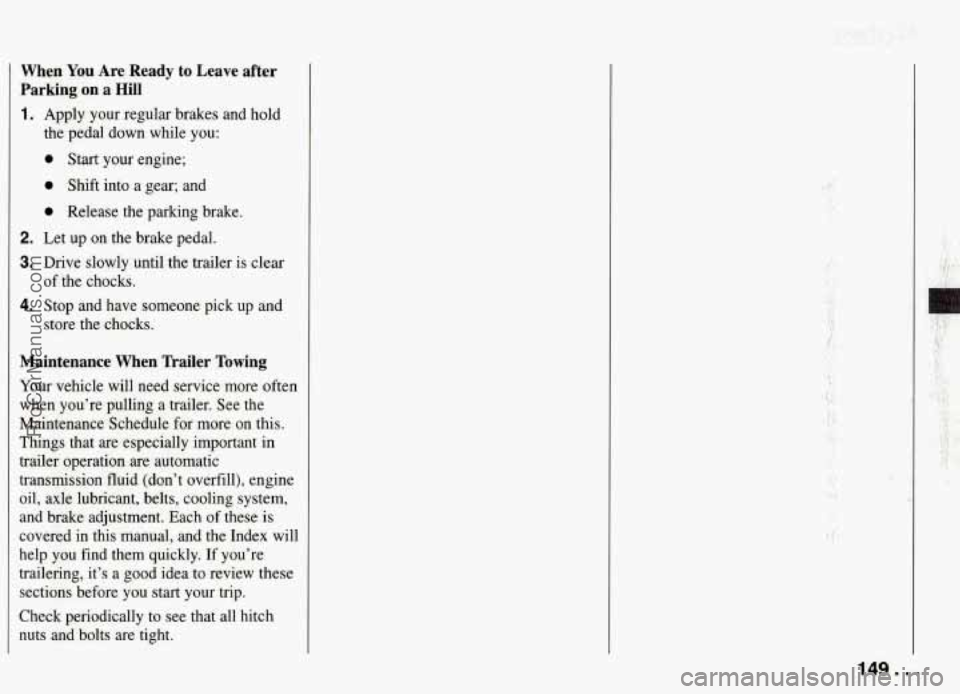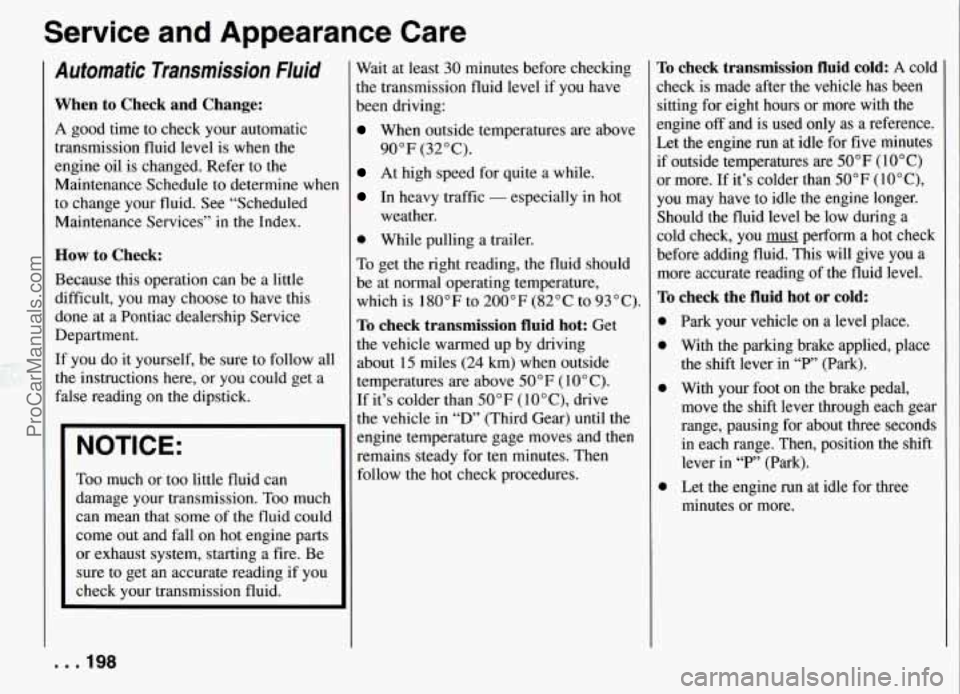maintenance schedule PONTIAC FIREBIRD 1994 Owners Manual
[x] Cancel search | Manufacturer: PONTIAC, Model Year: 1994, Model line: FIREBIRD, Model: PONTIAC FIREBIRD 1994Pages: 290, PDF Size: 14.84 MB
Page 2 of 290

Firebird
1994 0wn:er’s Manual
Table of Contents
Introduction
Part 1
Part 2
Part 3
Part 4
Part 5
Part 6
Part 9
Part 8
Part 9
How to Use This Manual ,, 3
Seats
& Restraint 6 Systems 7
Features & Controls m 41
Comfort Coqtrols
& Audio Systems 103
Your Driving and the
Road m 125
Probiems
on the Road = 151
& Appearance Care m =. 183
Maintenance Schedule
A = 239
Customer Assistance Information
m 259
Including “Reporting Safety Defects” on page 261.
hdeX smmmm=m.====mmmmm==.mm=mmmmm==m=mmm 269
Servi.ce Station Information
Last Page
Printed in U.S.A. Part No. 10260939 A Second Edition
1 ...
ProCarManuals.com
Page 4 of 290

How to Use This
Manual
Many people read their owner’s manual
from beginning to end when they first
receive their new vehicle. This will help you learn about the features and controls
for your vehicle. In this manual, you’ll
find that pictures and words work
together to explain things quickly.
~ Index: A good place to look for what
you need is the Index
in back of the
manual. It’s an alphabetical list of all
that’s in the manual, and the page
number where you’ll find it.
Parts 1-8: Each part of this manual
begins with a brief list of its contents,
so
you can often find at a glance if a part
contains the information you want.
How to Use This Manual: This part
tells you how to use your manual and
includes safety and vehicle damage
warnings and symbols.
Part 1 - Seats & Restraint Systems:
This part tells you how to use your seats
and safety belts properly.
It also
explains the air bag system.
Part 2 - Features & Controls: This
part explains how to start and operate
your Pontiac.
Part 3 - Comfort Controls & Audio
Systems:
This part tells you how to
adjust the comfort controls and how
to
operate your sound system.
Part 4 - Your Driving and the Road:
Here you’ll find helpful information
and tips about the road and how to drive
under different conditions.
Part 5 - Problems on the Road: This
part tells you what to do if you have a
problem while driving, such as a flat
tire or engine overheating, etc.
Part 6 - Service & Appearance
Care:
Here the manual tells you
how to keep your Pontiac running
properly and looking good.
Part 7 - Maintenance Schedule:
This part tells when to perform vehicle
maintenance and what fluids and
lubricants to use.
Part 8 - Customer Assistance
Information:
This part includes
important information about reporting
safety defects and gives
you details
about the “Roadside Assistance” program.
You will also find customer
satisfaction phone numbers (including
customer satisfaction numbers for the
hearing and speech impaired), as well
as the mediatiodarbitration procedure.
We’ve also included ordering
information for service publications in
this part.
Service Station Information: This is
a quick reference of service
information.
You can find it on the last
page of this manual.
3...
ProCarManuals.com
Page 150 of 290

When You Are Ready to Leave after
Parking on a
Hill
1. Apply your regular brakes and hold
the pedal down while you:
0 Start your engine;
0 Shift into a gear; and
0 Release the parking brake.
2. Let up on the brake pedal.
.
3. Drive slowly until the trailer is clear
4. Stop and have someone pick up and
of the chocks.
store the chocks.
Maintenance When Trailer Towing
Your vehicle will need service more often
when you're pulling a trailer. See the
Maintenance Schedule for more on this.
Things that are especially important in
trailer operation are automatic
transmission fluid (don't overfill), engine
oil, axle lubricant, belts, cooling system,
and brake adjustment. Each of these
is
covered in this manual, and the Index will
help you find them quickly. If you're
trailering, it's a good idea to review these
sections before you start your trip.
Check periodically to see that all hitch
nuts and bolts .are tight.
I
I
149.. .
ProCarManuals.com
Page 196 of 290

When to Change Engine Oil:
See if any one of these is true for you:
Most trips are less than 4 miles
0 It’s below freezing outside and most
trips are less than
10 miles ( 16 km).
The engine is at low speed most of
the time (as in door-to-door delivery,
or
in stop-and-go traffic).
(6 km).
You tow a trailer often.
Most trips are through dusty places.
If any one of these is true for your
vehicle, then you need to change your
and filter every
3,000 miles (5 000 km) or
3 months - whichever comes first.
If none of them is true, change the oil
every
7,500 miles (12 500 km) or 12
months
- whichever comes first.
Change the filter at the first oil change
and at every other oil change after that.
Engine Coolant Heater (Engine Block
Heater):
An engine coolant heater can be a big
help if you have to park outside in very
cold weather,
0°F (-18°C) or colder. If
your vehicle has this option, see “Engine Coolant Heater” in the Index.
What to Do with Used Oil:
Did you know that used engine oil
:ontains elements that may be unhealthy
:or your skin and could even cause
:ancer? Don’t let used oil stay on your
;kin for very long. Clean your skin and
lails with soap and water, or a good hand
:leaner. Wash or properly throw away
:lothing or rags containing used engine
il. (See the manufacturer’s warnings
ibout the use and disposal of oil
xoducts.)
Used oil can be a real threat to the
mvironment. If you change your own oil,
)e sure to drain all free-flowing oil from
:he filter before disposal. Don’t ever
jispose of oil by putting it in the trash,
2ouring it on the ground, into sewers, or
into streams or bodies
of water. Instead,
recycle it by taking it to a place that
collects used oil. If you have a problem
properly disposing of your used oil, ask
your dealer, a service station or a local
recycling center for help.
3.4L L32 (Code S
Air Cleaner
iefer to the Maintenance Schedule to
letermine when to replace the air filter.
See “Scheduled Maintenance Services”
In the Index.
t
195 ...
ProCarManuals.com
Page 199 of 290

Service and Appearance Care
Automatic Transmission Fluid
When to Check and Change:
A good time to check your automatic
transmission fluid level
is when the
engine oil is changed. Refer to the
Maintenance Schedule to determine when
to change your fluid. See “Scheduled
Maintenance Services” in the Index.
How to Check:
Because this operation can be a little
difficult, you may choose to have this
done at a Pontiac dealership Service
Department.
If you do it yourself, be sure to follow all
the instructions here, or
you could get a
false reading on the dipstick.
Too much or too little fluid can
damage your transmission. Too much
can mean that some of the fluid could
come out and fall on hot engine parts
or exhaust system, starting a fire. Be
sure to get an accurate reading
if you
check your transmission fluid. Wait
at least 30 minutes before checking
the transmission fluid level if you have
been driving:
When outside temperatures are above
At high speed for quite a while.
In heavy traffic - especially in hot
90°F (32°C).
weather.
While pulling a trailer.
To get the right reading, the fluid should
be at normal operating temperature,
which is 180°F to 200°F (82°C to 93°C).
To check transmission fluid hot: Get
the vehicle warmed up by driving
about
15 miles (24 km) when outside
temperatures
are above 50°F ( 10°C).
If it’s colder than 50°F ( lO”C), drive
the vehicle in
“D’ (Third Gear) until the
engine temperature gage moves and then
remains steady for
ten minutes. Then
follow the hot check procedures.
To check transmission fluid cold: A cold
check is made after the vehicle has been
sitting for eight hours or more with the
engine
off and is used only as a reference.
Let the engine run at idle for five minutes
if outside temperatures are 50°F
(10°C)
or more. If it’s colder than 50°F (lO°C),
you may have to idle the engine longer.
Should the fluid level be low during a
cold check, you must perform a hot check
before adding fluid. This will give you a
more accurate reading of the fluid level.
To check the fluid hot or cold:
0
Park your vehicle on a level place.
With the parking brake applied, place
the shift lever
in “P” (Park).
With your foot on the brake pedal,
move the shift lever through each gear
range, pausing for about three seconds
in each range. Then, position the shift
lever in “P” (Park).
Let the engine
run at idle for three
minutes or more.
. . .I98
ProCarManuals.com
Page 200 of 290

3.4L L32 (Code S)
Then, without shutting off the engine,
follow these steps:
1. Pull out the dipstick and wipe it with a
clean rag or paper towel.
1.7L LTI (Code P)
2. Push it back in all the way, wait three
seconds and then pull it back out
again.
3. Check both sides of the dipstick, and
i-ead the lower level. The fluid level
must be in the “COLD” area
for a colc
check
or in the “HOT” area or
cross-hatched area for
a hot check.
4. If the fluid level is in the acceptable
range. push the dipstick back
in all the
way.
How to Add Fluid:
Refer to the Maintenance Schedule to
determine what kind
of transmission fluid
to use. See “Recommended Fluids and
Lubricants”
in the Index.
199 ...
ProCarManuals.com
Page 201 of 290

Service and Appearance Care
If the fluid level is low, add only enough
of the proper fluid to bring the level up to
the “COLD’ area for a cold check or the
“HOT” area for a hot check. It doesn’t
take much fluid, generally less than a pint.
Don’t overfill. We recommend you use
only fluid labeled DEXRON@-I11 or
DEXRON@-IIE, because fluids with
that label are made especially for your
automatic transmission. Dama
e caused
by fluid other than DEXRON
-111 or
DEXRON@-IIE is not covered by your
new vehicle warranty.
0 After adding fluid, recheck the fluid
level as described under
“How to
Check.”
obtained, push the dipstick back in all
the way.
&
When the correct fluid level is
Manual Transmission Fluid
How to Check:
Because this operation can be difficult,
you may choose to have this done at a
Pontiac dealership Service Department.
If you
do it yourself, be sure to follow all
the instructions here, or you could get a
false reading.
NOTICE:
Too much or too little fluid can
damage your transmission.
Too rriuch
can mean that some of the fluid could
come out and fall
on hot engine parts
or exhaust system, starting a
fire. Be
sure to get
an accurate reading if you
check your transmission fluid.
Check the fluid level only when your
engine is off, the vehicle is parked on a
level place and the transmission is cool
enough for you to rest your fingers on the
transmission case.
Then, follow these steps:
1. Remove the filler plug.
2. Check that the lubricant level is up to
the bottom of the filler plug hole.
3. If the fluid level is good, install the
plug and be sure it is fully seated. If
the fluid level is low, add more fluid
as described in the next steps.
How to Add Fluid:
Here’s how to add fluid. Refer to the
Maintenance Schedule to determine what
kind of fluid to use. See “Recommended
Fluids and Lubricants” in the Index.
1. Remove the filler plug.
2. Add fluid at the filler plug hole. Add
only enough fluid to bring the fluid
level up to the bottom of the filler
plug hole.
3. Install the filler plug. Be sure the plug
is fully seated.
. . .200
ProCarManuals.com
Page 202 of 290

Hydraulic Clutch
The hydraulic clutch in your vehicle is
self-adjusting. The clutch master cylinder
reservoir is filled with hydraulic clutch
fluid.
It isn’t a good idea to “top
off’ your
clutch fluid. Adding fluid won’t correct a
leak.
A fluid loss in this system could indicate
a problem. Have the system inspected and
repaired.
When to Check and What to Use:
Refer to the Maintenance Schedule to
determine how often you should check
the fluid level in your clutch master
cylinder reservoir and for the proper fluid.
See “Owner Checks and Services” and
“Recommended Fluids and Lubricants”
in the Index.
How to Check:
The proper fluid should be added if the
level
is below the “STEP’ mark on the
reservoir. See the instructions on the
reservoir cap.
Rear Axle
When to Check and Change Lubricant:
Refer to the Maintenance Schedule to
determine how often to check the
lubricant and when to change
it. See
“Periodic Maintenance Inspections” in
the Index.
How to Check Lubricant:
If the level is below the bottom of the
filler plug hole, you’ll need to add some
lubricant. Add enough lubricant to raise
the level to the bottom of the filler plug
hole.
What to Use
Standard Differential
Use Axle Lubricant (GM Part No.
1052271) or SAE 80W-90 GL-5 gear
lubricant.
Limited-Slip Differential
To add lubricant when the.leve1 is
low, use Axle Lubricant (GM Part
No.
105227 1) or SAE 8OW-90 GL-5 gear
lubricant. To completely refill after
draining, add
4 ounces ( 1 18 ml) of
Limited-Slip Differential Lubricant
Additive (GM
Part No. 1052358). Then
fill to the bottom of the filler plug hole
with Axle Lubricant (GM
Part No.
12345977) or SAE 8OW-90 GL-5 gear
lubricant.
Engine Coolant
The following explains your cooling system and how to add coolant when
it is low. If you have a problem with
engine overheating or if you need to add
coolant to your radiator, see “Engine Overheating” in the Index.
I
201 . . .
ProCarManuals.com
Page 206 of 290

i w
R€
de
“€4
thc
1
hat to Add:
:fer to the Maintenance Schedule to
termine what kind
of fluid to use. See
!ecommended Fluids and Lubricants” ir
: Index.
NOTICE:
When adding power steering fluid or
making a complete fluid change,
always use the proper fluid. Failure
to use the proper fluid can cause leaks and damage hoses and seals.
Windshield Washer Fluid
To Add:
Open the cap labeled “WASHER FLUID
ONLY.” Add washer fluid until the bottle
is full.
NOTICE:
0
0
0
0
When using concentrated washer
fluid, follow the manufacturer’s
instructions for adding water.
Don’t mix water with
ready-to-use washer fluid; Water
can cause the solution to freeze
and damage your washer fluid
tank and other parts of the washer
system. Also, water doesn’t clean
as well as washer fluid.
Fill your washer fluid tank only
3/4 full when it’s very cold. This
allows for expansion, which could
damage the tank if it is completely
full.
Don’t use radiator antifreeze in
your windshield washer. It can
damage your washer system and
paint.
205. . . ProCarManuals.com
Page 207 of 290

Service and Appearance Care
Brake Master Cylinder
Your brake master cylinder is here. It is
filled with DOT-3 brake fluid.
There are only two reasons why the brake
fluid level in your master cylinder might
go down. The first is that the brake fluid
goes down to an acceptable level during
normal brake lining wear. When new linings are put in, the fluid level goes
back up. The other reason is that fluid is
leaking out of the brake system. If it is,
you should have your brake system fixed,
since a leak means that sooner or later
your brakes won’t work well, or won’t
work at all.
. . .206
So, it isn’t a good idea to “top off’ your
brake fluid. Adding brake fluid won’t
correct a leak. If you add fluid when your
linings are worn, then you’ll have too
much fluid when you get new brake
linings. You should add (or remove)
brake fluid, as necessary, only when work
is done on the brake hydraulic system.
Refer to the Maintenance Schedule to
determine when to check your brake
fluid. See “Periodic Maintenance
Inspections’’ in the Index.
To Check Brake Fluid:
You can check the brake fluid without
takmg
off the cap. Just look at the brake
fluid reservoir. The fluid level should be
above the plastic seam
in the reservoir.
If
it isn’t, have your brake system
checked to see if there
is a leak.
After work is done on the brake hydraulic system, make sure the level is above the
plastic seam, near the base of the filler
neck.
ProCarManuals.com